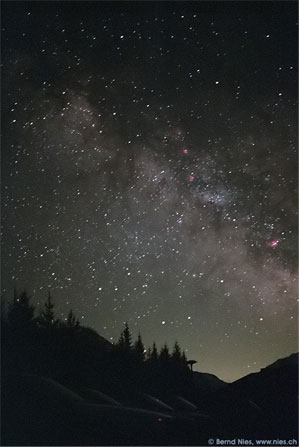
Main sequence stars: A starry sky with the Milky Way galaxy (thanks to Bernd Nies)
What is a main sequence star?
Nine out of ten stars that you see in the sky are main-sequence stars, and our sun is one of them.
More about the sun
What are stars made of?
Brown dwarfs
Different types of stars
All our physics articles
Most main-sequence stars probably started out as brown dwarfs, and then succeeded in getting enough mass together to begin a nuclear fusion reaction inside them.
What makes these stars shine?
It’s the energy from this nuclear fusion reaction, changing hydrogen atoms into helium atoms and releasing the extra energy, that makes the stars shine.
What is a fusion reaction?
Nuclear fusion project
Gravity and the fusion reaction
What holds a star together is a balance of two forces pushing against each other. Gravity pulls the star’s atoms in towards the center, just as gravity pulls you toward the Earth. The fusion reaction going on inside the star pushes the atoms away from the center, towards space.
What is gravity?
What’s in an atom?

The sun from space: a main sequence star
When these two forces are equal, the star can continue existing. Generally the two forces do stay in balance. That’s because whenever the fusion reaction begins to slow down, it doesn’t push out as much. Then the gravity can push in more, and that forces the hydrogen atoms closer together, which starts up the fusion process again and restores the balance.
What shape is a star?
Because the forces pushing in and out are the same in all directions, stars are basically shaped like balls. But because stars also spin around, centrifugal force tends to flatten out the ball a little, so most stars are a little thicker around the middle than they are at the top or bottom.
More about centrifugal force
From main sequence stars to supergiants
Main-sequence stars fall out of balance when they have used up all of their hydrogen fuel. Bigger stars, which burn hotter, use up their fuel faster, and smaller, cooler stars last longer.
Big numbers: what’s a trillion?
The biggest main-sequence stars last only a few million years, while the smallest main-sequence stars last over a trillion years. Once the star has used up all its fuel, it expands into a supergiant star.




